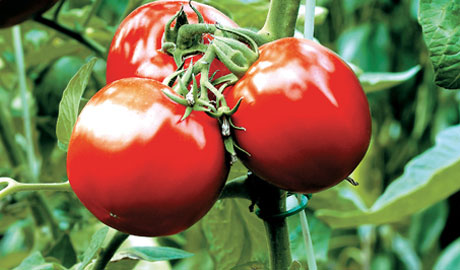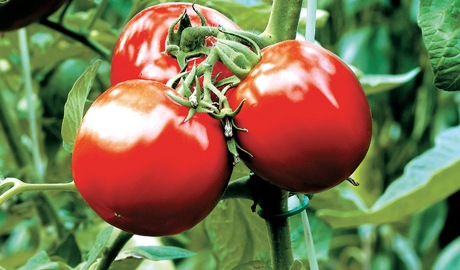The Basics of Growing Tomatoes
June 07, 2011
 How To Grow ‘Em
How To Grow ‘Em
Tomatoes like lots of sun, warm weather and well drained soil that’s slightly acidic. (6.5 is an ideal pH.) If you’re starting out with clay or rocky soil, you’ll definitely want to improve it with lots of compost and/or peat moss.
Wait until after all danger of frost has passed to plant. Around here, that usually means mid-May. (Mother’s Day is a landmark many central-Pennsylvania gardeners use.)
Avoid planting in extremely windy areas, and stay well away from walnut trees, which emit a chemical (juglone) that’s deadly to tomatoes.
Plant your tomato plants 18 to 24 inches apart. Some gardeners remove all but the top set of leaves and plant the plants deeply. Some even plant tomatoes sideways in a shallow trench with only the top leaves sticking out under the theory that an elaborate root system will develop all along the stem.
It’s true that tomatoes have the ability to grow new roots from buried stems, but studies at Ohio State University found that it does more harm than good to remove lower leaves. Fewer leaves mean less energy that the young plant can produce for use in growing roots. Our advice is to plant tomatoes as deeply as you can without removing any leaves.
Water each plant with a cup of liquid fertilizer that’s not too high in nitrogen. We recommend an organic product such as fish emulsion or high-phosphorus chemical fertilizers such as Root Stimulator, Ferti-Lome Blooming and Rooting Soluble Plant Food or half-strength Miracle-Gro. Too much nitrogen can lead to lots of foliage but small fruits and lower yields. If you prefer granular fertilizer, mix a high-phosphorus one into the planting hole before planting.
Tomatoes grow well with a black plastic or straw mulch. Water the ground well before applying the mulch. Recent tests have found that red plastic mulch increases yields and even reduces disease as well as stopping weeds and warming the soil.
During the growing season, make sure your plants get a good soaking about once a week. The ground should be wet at least 6 to 8 inches down when you’re done. Don’t overdo it, though, especially later in the season, or your tomatoes will get watery.
Most gardeners fertilize once or twice more during the growing season, especially when the plants begin to set fruit.
The Great Staking Debate
There’s more than one way to stake a tomato, from wooden stakes to cages to trellises. Whatever system you use, grow up. Support your local tomatoes. They’ll be cleaner and less prone to disease than if you let them sprawl over the ground.
If you tie plants to a stake, use a soft material such as old cut-up nylons or insulated twisty-ties so you don’t damage the stems.
If you go with tomato cages (ready-made ones or ones you craft out of fencing), support them with at least one stake so they don’t fall over or blow over.
If you’re growing more than a few plants, it pays to go with either the “stake-and-weave” system or a “tomato wall.” The first system involves hammering stakes every 4 feet apart in a line and then weaving twine or rope on alternate sides of your plants as you go down the row. Then weave the opposite sides on the way back. Add more levels as the plants grow. With the “tomato wall,” hammer stakes every 4 or 5 feet apart and then attach a fence with wide openings to it. Grow your tomatoes up the fence, weaving the branches in and out of the fencing for support. (No ties are needed.)
What Can Go Wrong?
One of the most common tomato problems is blossom-end rot, a condition in which the bottom end of the fruit turns black and mushy. Prevent it by adding calcium to the soil (eggshells, lime or gypsum are sources) and by keeping the soil evenly moist.
Tomatoes also are sometimes prone to wilt and blight diseases. Prevent these by choosing disease-resistant varieties (look for letters like VFNT after the name) and by never planting tomatoes in the same spot for at least three years. Fungicides also are available.
Hornworms occasionally chew tomato foliage, but they can hand-picked and destroyed or killed with a spray of Bt (Bacillus thuringiensis). Do NOT harm hornworms that have what look like white grains of rice on their back. These are parasitic wasp eggs that will hatch to control the problem for you very shortly.
Whiteflies also are an occasional problem, and these can be controlled with an insecticidal soap or by placing yellow boards coated with Tangle Trap to trap them.
Don’t store your vine-ripened tomatoes in the refrigerator. That can kill the taste. And don’t forget to pick those last tomatoes before a killing frost in fall. You can ripen ‘em in a paper bag.
